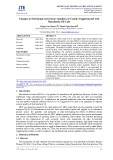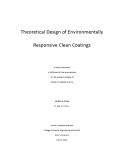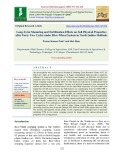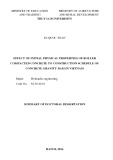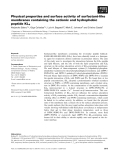
CÔNG NGHỆ https://jst-haui.vn
Tạp chí Khoa học và Công nghệ Trường Đại học Công nghiệp Hà Nội Tập 61 - Số 1 (01/2025)
158
KHOA H
ỌC
P
-
ISSN 1859
-
3585
E
-
ISSN 2615
-
961
9
A STUDY ON THE REACTIVITY AND PHYSICOCHEMICAL
PROPERTIES OF COATINGS BASED ON ACRYLATED BLACK
SEED OIL COATINGS THROUGH CROSSLINKING
AT AMBIENT TEMPERATURE
NGHIÊN CỨU KHẢ NĂNG PHẢN ỨNG VÀ TÍNH CHẤT CƠ LÝ CỦA LỚP PHỦ
TRÊN CƠ SỞ DẦU HẠT CÂY ĐEN ACRYLAT HÓA
BẰNG PHƯƠNG PHÁP KHÂU MẠCH Ở NHIỆT ĐỘ THƯỜNG
Dam Xuan Thang1,*
DOI: http://doi.org/10.57001/huih5804.2025.025
ABSTRACT
Environmentally friendly organic coatings which are water-based, have low or no solvents and good physical properties based on the
use of acrylate
monomers/acrylate oligomers originating from vegetable oils are gaining attention as we move towards sustainable chemistry. U
sing thermal methods with
acrylate and methacrylate monomers in the presence of initiators produces transparent fil
ms. An analysis on the influence of the nature of initiators shows that
the activity of initiators is arranged in the order: D.1173 > PI.907 > I.184 > TPO > PI.PB, and the content of D.1173 initiat
ors at 3% of the reaction occurs quickly
after 3 hours at 40°C, producing a tightly crosslinked transparent film. The reactivity and properties of the coatings formed by acrylated blac
k seed oil at ambient
temperature have been studied using internal calibration, testing relative hardness, gel content, swelling ra
tio, impact resistance, and gloss. The research results
provide a basis for the development of advanced, environmentally friendly organic coatings using black seed oil - a type of vegetable oil with naturally-
epoxidized groups native to Vietnam.
Keywords: Acrylated black seed oil, thermal crosslinking, organic coatings, initiators.
TÓM TẮT
Lớp phủ hữu cơ thân thiện môi trường, ít hoặc không có dung môi, gốc nước và có tính chất cơ lý tốt trên cơ sở sử dụ
ng các monome acrylat/oligome acryla
có nguồn gốc từ dầu thực vật ngày càng được chú trọng để hướng tới hóa học bền vững. Các monome acrylat và metacrylat phương pháp nhiệt với sự có mặt củ
a
chất khơi mào tạo ra mang trong suốt. Phân tích ảnh hưởng của bản chất chất khơi mào cho thấy, hoạt tính của chất khơi mào được sắp xếp theo thứ tự:
D.1173
> PI.907 > I.184 > TPO > PI.PB và hàm lượng chất khơi mào D.1173 3% phản ứng xảy ra nhanh sau 3 giờ ở 40oC, màng trong suốt tạo mạng lưới chặt chẽ. Khả
năng phản ứng và các tính chất của lớp phủ tạo bởi dầu hạt cây đen acrylat ở nhiệt độ thường đã được nghiên cứu bằng phương pháp nội chuần, thử nghiệm độ
cứng tương đối, phần gel, độ trương, độ bền va đập và độ bóng. Kết quả nghiên cứu là cơ sở để đưa dầu hạt cây đen - một loại dầu thực vật có nhóm epoxy t
ự
nhiện ở Việt Nam cho sự phát triển lớp phủ hữu cơ tiên tiến, thân thiện môi trường.
Từ khóa: Dầu hạt cây đen acrylat hóa, khâu mạch nhiệt, lớp phủ hữu cơ, chất khơi mào.
1Faculty of Chemical Technology, Hanoi University of Industry, Vietnam
*Email: thangdx@haui.edu.vn
Received: 06/6/2024
Revised: 29/10/2024
Accepted: 26/01/2025






